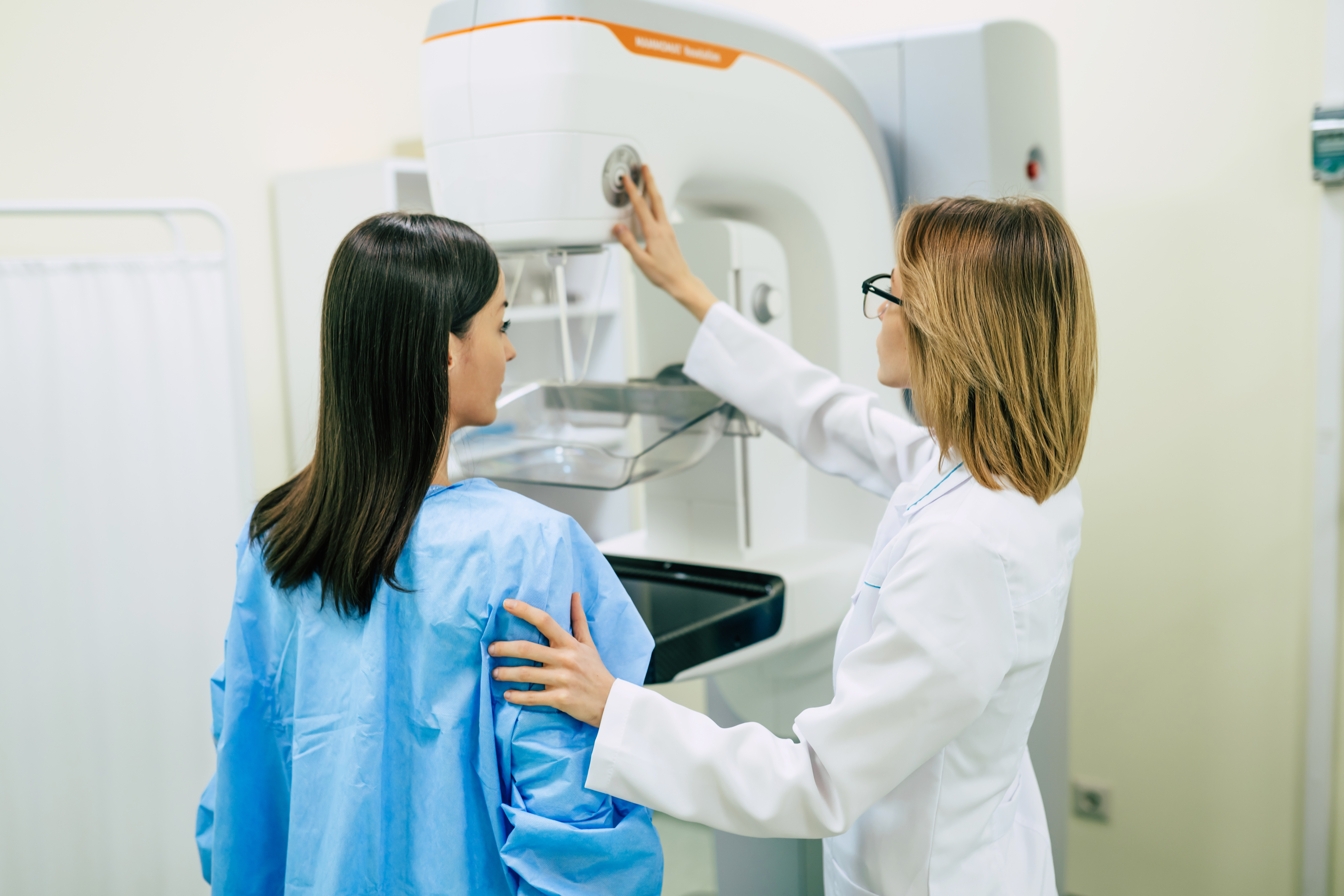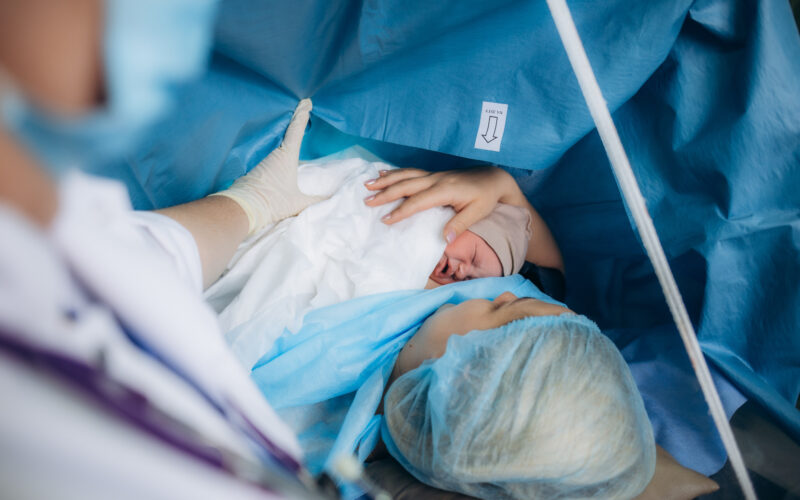When a baby is born via cesarean section (C-section), informed consent requires that the mother be educated about unlikely but possible risks like surgical infection, excessive bleeding, etc. However, the long-term effects of a C-section delivery on a child’s development are less frequently discussed. From increased risk of obesity to atopy, the road to understanding how C-sections shape a child’s future— spoiler: the lack of contact with the mother’s vaginal microbioma during birth may play a role— is just beginning to unfold.
How many pregnancies end in a Cesarean section?
Before we address the long-term health risks children born via C-section may face, let’s look briefly at the scope of how many children are even affected. According to the World Health Organization, there are too many C-sections, with more than 1 in 5 births across the world by C-section. Furthermore, that number is expected to increase to 1 de cada 3 by 2030 [1].
In Latin America and the Caribbean, C-sections account for 43% of all births. Furthermore, C-sections now outnumber vaginal births in the Dominican Republic, Brazil, Cyprus, Egypt, and Turkey. These numbers are concerning for many reasons, but as this article will focus upon, particularly because of the potential long-term health implications for children born via unnecessary Cesarean birth.
What long-term health risks may children face?
According to a 2022 study in Cell Host & Microbe, infants delivered by C-section are at higher risk for “a range of chronic inflammatory and metabolic conditions, with the most evidence for obesity and atopy [tendency to develop allergic diseases] but also including systemic connective tissue diseases, juvenile arthritis, inflammatory bowel disease, immune deficiencies, and leukemia” [2]. We’ll cover the evidence on the two strongest connections, C-section birth with obesity and atopy risk, here.
What’s the theme connecting the increased risk of these varied health problems?
The throughline between Cesarean birth and each of the chronic inflammatory and metabolic conditions listed above seems to be the lack of vaginal “seeding” of gut flora (bacteria) that happens when the baby passes through the birth canal. In the womb, babies are protected from outside germs, so the first external bacteria they come into contact with during and after birth “seed” their guts, mouths, and skin.
While children born vaginally are immediately exposed to bacteria from their mother’s vaginal and perineal (yes, including her stool) microbiome, those born via Cesarean primarily have their guts seeded with bacteria from the mother’s skin and the surrounding hospital environment [3]. The seeding or bacterial colonization that occurs during birth helps to prepare the child’s immune system to respond to attacks throughout their life. Some investigación has found that these differences in gut bacteria can still be found up to seven years after birth [4].
Let’s take a deeper look at how these conditions may relate back to not having the “bacterial baptism” of a vaginal birth.
Why does vaginal seeding make a difference?
Según un writeup of a 2018 study, “humans are born germ-free and it is during birth when important bacteria are transmitted and start to colonize in the body. It has long been suggested that this early colonization can alter an individual’s health in later life” [5]. The study author explained, “This may explain why, epidemiologically speaking, cesarean-born children suffer more frequently from chronic, immune system-linked diseases compared to babies born vaginally. It could be that the immune system of these children is set on a different path early on’” [5].
En Centro Nacional de Investigación Sanitaria notes, “this bacterial exposure [from vaginal delivery] is thought to help babies develop their immune system through a theory called ‘oral tolerance.’ The theory of oral tolerance suggests that the immune system is less sensitive to antigens (toxins and foreign substances such as bacteria) that your body has already experienced. The theory suggests that this early exposure helps the baby develop a healthy immune system and microbiome.”
Obesidad
A 2024 Taiwanese study published in the Journal of the Formosan Medical Association studied a total of 1,884,701 children from birth to at least age 5 to determine if being born via C-section increased the chance of several factors, including obesity [6].
They found that “cesarean birth was associated with a higher risk of childhood overweight/obesity, even after adjusting for confounding factors, such as maternal immune disorder, pregnancy complications, and child demographic.” The authors noted that their findings were consistent with the results of multiple previous global studies, including a 2015 meta-analysis finding that compared to those born vaginally, children born via C-section had a 34% higher risk of developing obesity during childhood.
[In a 2018 study,]compared to those born vaginally, children born via C-section had a 34% higher risk of developing obesity during childhood.
When looking at the actual numbers from this study, 0.15% of children born via C-section developed obesity, compared to 0.11% of children born vaginally. Contextually, out of a group of almost two million subjects, this increased risk represents approximately 800 additional cases of childhood obesity.
Atopy
Atopy refers to a group of allergy-related conditions, specifically asthma, eczema, and hay fever.
The Taiwanese study mentioned previously also referenced a meta-analysis of 37 different studies and 5 million children worldwide which found that children born via either elective or emergency C-section were at a 20% higher risk of childhood asthma compared to children born vaginally [7]. Additionally, a 2019 population-based study found Cesarean sections were a prenatal risk factor for childhood asthma, increasing risk by 10% compared to vaginally born babies [8].
[A 2019 meta-analysis found that] children born via either elective or emergency C-section were at a 20% higher risk of childhood asthma compared to children born vaginally
A meta-analysis of 113 studies published in the Journal of Allergy and Clinical Immunology found that compared to babies born vaginally, those born via C-section were at increased risk for all forms of atopy. They were 15% more likely to develop hay fever (38.9% for C-section delivered babies and 36.6% for vaginal delivery), 8% more likely to develop eczema (20.2% for CD versus 18.8% for VD), and 35% more prone to food allergies (0.02% for CD and 0.01% for VD) [9].
Are immune system differences in C-section vs vaginal births due to maternal health factors or to vaginal seeding?
Is the lack of siembra vaginal responsible for the increased risk of obesity, atopy, and other chronic inflammatory conditions in babies born via C-section? As the researchers behind the 2022 study in Cell Host & Microbe observed, “some also argue that maternal and prenatal factors necessitating a C-section delivery may also play a role in the development of these C-section-associated diseases” [2] (emphasis added).
As the researchers summed up when considering the research to date, it appears that ambos maternal prenatal health y lack of vaginal seeding play a role in the increased risk in Cesarean-born babies. More specifically, how robustly a child responds to vaginal seeding may be affected by prenatal maternal health factors. “This suggests that not only does the composition of the inoculate matter, but also the prenatal environment shapes the post-natal response to inoculation” [2].
[I]t appears that ambos maternal prenatal health y lack of vaginal seeding play a role in the increased risk in Cesarean-born babies.
It’s possible that “not all C-section-delivered infants may benefit from maternal-child seeding equally, and maternal prenatal history may be important to collect in clinical trials to provide insight into post-natal responses to seeding” [2].
What about babies whose mothers received antibiotics?
We know that antibiotics wipe out both good and bad bacteria, and mothers who deliver via Cesarean section routinely receive antibiotics to prevent infection. The researchers in the 2022 Cell Host & Microbe study acknowledge the possibility that antibiotic administration is a confounding factor, noting, “Early life antibiotic exposure has been associated with inflammatory diseases in offspring that are also positively associated with C-section delivery, including obesity and atopy (Cox et al., 2014).” However, a 2017 study on mice found that when mice mothers had C-sections (yes, C-sections on mice!) but no antibiotics, their babies still had a higher risk of excessive weight gain [10].
As with the possibility (noted above) that prenatal maternal health factors impact the effectiveness of vaginal seeding, the researchers suspect this is another both/and situation. They wrote, “It is likely that the effect on outcomes in humans is compounded by both C-section and antibiotic exposure together” [2]. To better clarify the role of antibiotics vs. the lack of siembra vaginal, the researchers are currently conducting a randomized controlled trial, set to end in 2029.
The bottom line on the long-term effects of C-sections on children
The biggest takeaway from research pointing to long-term health impacts on babies born via C-section? C-sections are not risk-free in the short- or long-term, so only medically necessary C-sections should be performed.
Practically speaking, this should encourage healthcare professionals to do away with the practice of automatic repeat Cesareans (more TOLACs with the goal of PVDC, please!), or Cesareans scheduled for convenience of the doctor or the mother. If a pregnant mother needs to have a C-section for her or her baby’s health (as some certainly do!), she can also insist on siembra vaginal. Vaginal seeding is not a guarantee against the possible long term effects of C-section discussed above, but it is perhaps the closest a mother can get (at present) to mimicking the “bacterial baptism” of a vaginal birth for her baby.
As a mother who had a planned C-section with a breech baby and then a VBAC, I can attest that, while a C-section es major abdominal surgery, the entirety of my unmedicated birth I half-joked with my nurses to “please just cut me open already to make the back labor stop!” While I naturally wished for less pain in the moment, ensuring a Cesarean delivery is actually medically necessary should be the main reason a mother and baby go through this procedure, which carries risks for both parties.
Referencias:
[1] Słabuszewska-Jóźwiak, A., Szymański, J. K., Ciebiera, M., et al. (2020). Pediatrics Consequences of Caesarean Section-A Systematic Review and Meta-Analysis. Revista internacional de investigación medioambiental y salud pública, 17(21), 8031. https://doi.org/10.3390/ijerph17218031 [2] Hourigan, S. K., Dominguez-Bello, M. G., & Mueller, N. T. (2022). Can maternal-child microbial seeding interventions improve the health of infants delivered by Cesarean section?. Cell host & microbe, 30(5), 607–611. [3] Song SJ, Wang J, Martino C, et al. Naturalization of the microbiota developmental trajectory of Cesarean-born neonates after vaginal seeding. Med. 2021 Aug 13;2(8):951-964.e5. doi: 10.1016/j.medj.2021.05.003. Epub 2021 Jun 17. PMID: 35590169; PMCID: PMC9123283. [4] Szajewska H. MODE OF DELIVERY AND ITS IMPACT ON GUT MICROBIOTAArchives of Disease in Childhood 2008;93:s3. [5] Wampach, L., Heintz-Buschart, A., Fritz, J.V. et al. Birth mode is associated with earliest strain-conferred gut microbiome functions and immunostimulatory potential. Nat Commun 9, 5091 (2018). https://doi.org/10.1038/s41467-018-07631-xReferencias, Cont.
[6] Chua WC, Chen YL, Yen CF, Chen HL. Long-term health outcomes of children born by cesarean section: A nationwide population-based retrospective cohort study in Taiwan. J Formos Med Assoc. 2024 Oct 1:S0929-6646(24)00444-3. doi: 10.1016/j.jfma.2024.09.024. Epub ahead of print. PMID: 39358115. [7] Darabi, B., Rahmati, S., HafeziAhmadi, M.R. et al. The association between caesarean section and childhood asthma: an updated systematic review and meta-analysis. Allergy Asthma Clin Immunol 15, 62 (2019). https://doi.org/10.1186/s13223-019-0367-9 [8] Lin, CH., Wang, JL., Chen, HH. et al. Shared prenatal impacts among childhood asthma, allergic rhinitis and atopic dermatitis: a population-based study. Allergy Asthma Clin Immunol 15, 52 (2019). https://doi.org/10.1186/s13223-019-0365-y [9] Liu X, Zhou J, Chen J, et al. Risk of Asthma and Allergies in Children Delivered by Cesarean Section: A Comprehensive Systematic Review. J Allergy Clin Immunol Pract. 2024 Oct;12(10):2764-2773. doi: 10.1016/j.jaip.2024.06.022. Epub 2024 Jun 20. PMID: 38908434.
[10] Martinez KA 2nd, Devlin JC, Lacher CR, et al. Increased weight gain by C-section: Functional significance of the primordial microbiome. Sci Adv. 2017 Oct 11;3(10):eaao1874. doi: 10.1126/sciadv.aao1874. PMID: 29026883; PMCID: PMC5636202.











